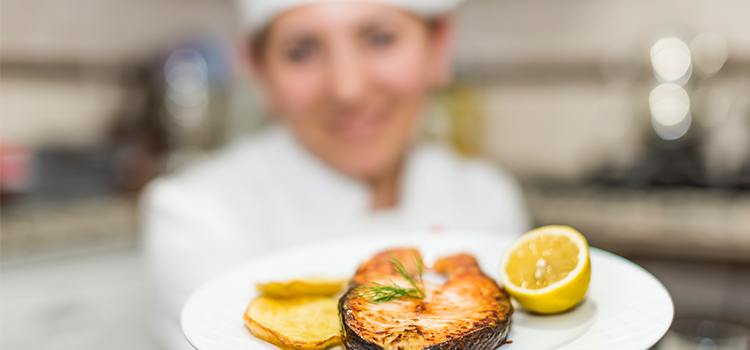Chef Interview: An Inside Look at Chef Jobs
Find out what chef jobs are really like from Christine Keff.

Christine Keff
Chef, Former Restaurant Owner – Flying Fish, Seattle
Over 27 years in business, 10 as a restaurant owner
How did you get started?
I fell into a job making salads. That was it. I liked the people, the pace. It was fun. Later I talked myself into an apprenticeship program at the Four Seasons in New York. They had a program for young cooks who had been through culinary school. I hadn't been, but they took me on. It was a formal apprenticeship program, working different stations, rotating. The ones who were really interested would work 13 or 14 hours a day, work a regular shift and stay late to help the butcher. It was a good time.
Later, I worked for a lot of restaurants in New York. I'd find a different station in the kitchen—the fish station or the sauté. I moved around, tried to stay a year at each place if possible, but not much more than that. Nobody teaches you how to be a chef; you have to figure it out. If you see a lot of different styles, you can see how you want to do it and pick yours.
What does it mean to be a chef?
Chef is French for boss. They are ultimately responsible for everyone in the kitchen. The chef arrives at 10 or 11 in the morning. He takes care of problems—something hasn't come; something has to be sent back. He makes the menu for that day and gets everything ready for the cooks. When the cooks arrive, he shows them the menu for the day and supervises the set-up. If there's a new dish the chef cooks that the first few times, makes the sauces, the vegetable that goes with it.
Just before 5 o'clock, the chef talks to all the waiters, tells them where the fish is from, tells them about new dishes, gives them a taste. Then the service starts, and he leads the line. He calls orders and coordinates so that every dish on a ticket comes out together. When dinner slows down, the chef does the ordering for the next day. His work day may end at 11 or 12 at night.
What is the best part about the job?
The best part is having a concept or an idea about a dish and working with several different people to make it happen. I can't touch every plate. There are another five or six people involved in making one dish. It's challenging and rewarding to get them all to do their part properly, at the right time, so the plate I end up handing to the waiter matches my original plan for the food.
What do people need to know before entering the field?
It's good to work in a kitchen as much a possible, even before you go to an expensive school. You have to learn to take the heat—literally.
Pay attention to art! There are two parts: the creative part, which requires delicacy and a palate, and there's the hard work, the drudgery of working in a kitchen, and that's 75 percent. You have to be a bit of a drone, you have to be willing to clean three cases of whatever without losing your mind. I spend a lot of time looking at art books. It helps with plate design, color and all that. You try to have that make sense with actual food.
What misconceptions do people have coming into a chef job?
Some people think that as soon as you graduate from culinary school you are a chef. But school is not a restaurant. It takes a lot longer than you think to be a really good chef. Many people take a chef job before they're ready. It's harder to go back once you've started making some money and getting prestige. Then it seems shameful to go back and learn what you didn't learn. I counsel people to be a little bit patient, work at a lot of different places. There are so many things you need to learn as a cook before you go on to be a chef. A lot of people end up in over their head.
Culinary Arts Schools & Careers
- A Professor's Advice About Culinary Schools
- Chef Interview: An Inside Look at Chef Jobs
- Chef Job Description
- Chef Job Outlook
- Choosing a Culinary Arts Program
- Compare Culinary Careers
- Cooking School Student Profile
- Culinary Arts Salary Information
- Culinary Arts Schools Offer Career Help
- Culinary Externships Equal Work Experience
- Culinary School and Career Resource Center
- Find Local Cooking Classes to Fit Your Goals
- Helpful Resources for Culinary Careers
- Is Culinary School Worth the Time and Tuition?
- Jobs for Chef School Graduates
- Recreational Cooking Classes
- Top 10 Essential Cooking Tools
- What is Culinary School Really Like?
FIND A CULINARY SCHOOL TODAY
Tell us a little about yourself and we'll connect you with schools that offer culinary arts programs.
